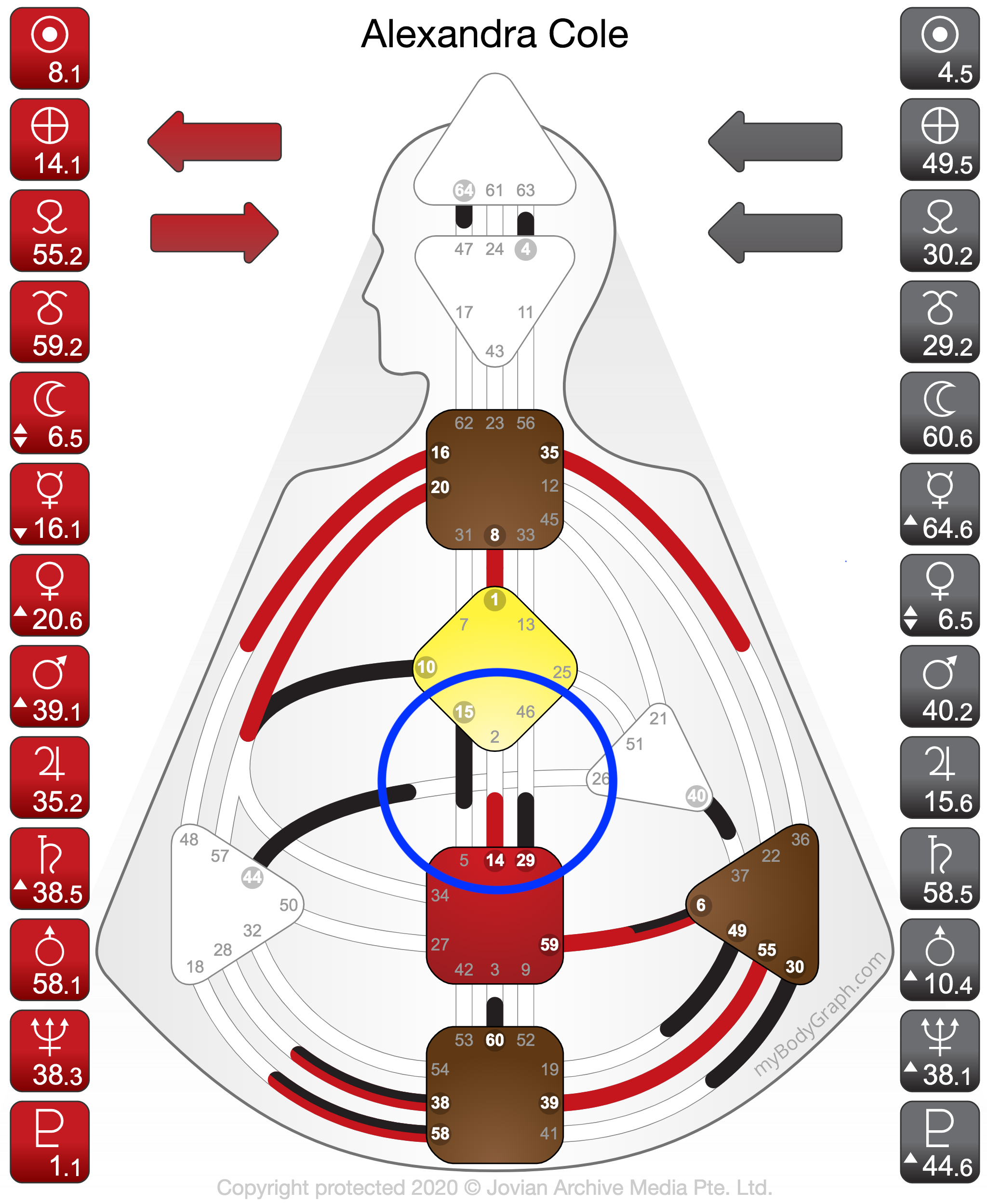
I was first introduced to Human Design in 2018. As someone who has always been keen to take any type of personality test or quiz, my curiosity was instantly peaked. I was particularly intrigued by its many layers and the connection to so many other ancient traditions. Once I started studying Human Design, both formally and informally, I also experienced first-hand how powerful it is to lean into your design. It gives you permission to stop forcing yourself to fit into a certain mold and embrace your unique talents and traits. In many ways, it was the perfect complement to the work I was doing to help others find and live out their purpose.
However, as I started to evangelize Human Design to my friends and family, I struggled to find resources that were written in relatable, layman terms. So, I decided to create this beginners guide to offer a basic overview of what Human Design is and how you can start to decipher the foundations of your own chart. This post is not meant to be a substitute for a personal reading, but it will give you a better understanding of the building blocks so you know where to focus your attention and what to research further.
HOMEWORK: If you have not downloaded your chart yet, I recommend generating one at www.mybodygraph.com.
So what is Human Design really?
The most basic way to describe Human Design is as a personality test. But there is a lot more to it than that. Human Design is quite literally the study of who a human is designed to be. It draws on ancient traditions such as the Chinese I-Ching, the kabbalah, the chakra system, and of course, astrology, to generate a unique (and rather complex-looking) blueprint of your most authentic self, based on your birth date, time, and location. This also means that unlike other personality tests, your chart is fixed. It is not based on a series of subjective questions (to which your answers may change over time) and the implications are not limited to one specific area of your life (career, relationships, etc.).
The underlying premise is that we are all born with an individual set of curiosities, talents, and points of view. Over time, however, we start to make compromises (i.e. we get “conditioned”). We adapt to our surroundings and present ourselves in a way that results in the least amount of friction with the world around us. Humans are wired to want to belong, so it’s only natural that we learn to ignore the parts of ourselves that are different in order to “fit in” and live up to the expectations of our family, friends, teachers, and colleagues. But that’s exactly where we go wrong.
Your chart reflects who you were born to be. Understanding your design gives you permission to embrace this true self and let go of the conditioning you may have picked up along the way. It encourages you to lean into your natural gifts and stop agonizing on who or what you are not.
Making sense of your chart
When you first look at your chart, it can be quite overwhelming. To me, it’s reminiscent of a half-finished paint-by-numbers picture. In this post, I want to explain some of the primary principles of Human Design in the hopes of making it more accessible to those who are new to this practice. (It’s important to note, however, that Human Design is very complex, so we will barely be scratching the surface.)
I will touch on the core principles in the same order as I would when doing a reading for someone. We’ll start at the highest (most universal) level with the five energy types and work our way down to the more personal and individual elements of a chart (the gates and channels).
The Energy Types
There are five energy types: Manifestor, Manifesting Generator, Generator, Projector, and Reflector. These energy types form the foundation of Human Design. Your energy type suggests how you are meant to use your energy in the world in order to experience the least amount of friction and the most amount of ease (or flow). Friction happens when you’re not operating in alignment with your energy type—in other words, when you’re trying to be someone you’re not designed to be. For example, as a Generator, I have fairly consistent energy throughout the day. From the moment I wake up to the moment my head hits the pillow, I’m pretty much go-go-go. My Projector husband, on the other hand, is designed to expend his energy in waves. He can work very intensely for short periods of time but will inevitably hit a wall after a few hours. If he tries to match my Generator work schedule, he will become less and less productive as the day goes on. He is best served to work for 4 hours straight and then relax and refuel. The outcome of a day’s work may be identical, but how we achieve this outcome is very different.
Fun Fact: Certain energy types are more prevalent than others because the distribution of energy types evolves depending on what the world needs.
HOMEWORK: I recommend learning more about your energy type HERE. If you are completely new to Human Design, learning to embrace and master your energy type can have a tremendous impact on your day to day experience.
The Energy Centers
Every chart has nine geometric shapes that are connected by a lot of lines. These geometric shapes can be square or triangular; and they can be colored or white. The energy centers map to the Chakra system – starting at the root and ending at the crown. Each energy center represents (or “rules” in astrological terms) an important aspect of your inner or outer world: your desires, fears, emotions, sense of direction, communication, opinions, and inspiration. When an energy center is colored it is defined, which means you were designed to have a personal point of view in this particular area. In other words, you have your own “default setting”. When a center is white or undefined, you do not have your own default setting and are therefore more sensitive to picking up on other peoples’ fears, opinions, etc. It will come as no surprise that the undefined centers are also where you’re most prone to conditioning. For example, my spleen center (which rules fears and intuition) is undefined, suggesting that I am quite sensitive to picking up on other people’s fears.
HOMEWORK: Look at your chart and identify which energy centers are defined vs. undefined. HERE is a helpful overview for you to start understanding how this definition may manifest itself in your life and personality.
The Profiles
The profiles in human design are like archetypes. Similar to your sun sign in astrology, they represent how you move through the world. There are 12 profiles and each profile consists of two numbers (ex: 5/1, 1/3, 4/6). The first number reflects the part of you that you are most conscious of, while the second number reflects how others see you (which may not be as obvious to you). To master your profile, you have to learn to embrace the second number.
The profiles are one of my favorite aspects of Human Design because they can result in the greatest aha-moments: “That’s why I have so much trouble with x, or that’s why I feel this enormous pressure to y.” Your profile also suggests whether you have a personal or a transpersonal karma. In other words, whether your life’s work should be accomplished through inner (personal) or outer (transpersonal) focus.
HOMEWORK: Locate your profile in your chart information and use THIS ARTICLE to start to educate yourself on the second number: How can you start to embrace this side of yourself more?
The Gates
This is where it starts to get more personal (and interesting!). Whereas you may share an energy type and a set of defined or undefined energy centers with other people you know, none of them will have your unique combination of gates. The “gates” are the shorter, colored lines that originate in the energy centers. Gates only reach halfway across from one energy center to another (vs. a “channel” which connects two energy centers). Each gate represents a “potential”. The gates that are colored in your chart suggest another default setting for how you think, do, relate, and emote.
This is where Human Design becomes a true artform. Many people may share a specific gate, but it will express itself differently depending on the bigger picture: your energy type, defined and undefined energy centers, your profile, etc. A competent reader will be able to provide insights that take all of these nuances into account.
For example, gate 53 originates in the root center and refers to a pressure to start or generate momentum. How I advise someone to use this gate will vary based on their energy type. I may encourage a Generator to respond to this pressure to start something new whenever it feels like a HELL YES; however, a Projector may need to be more protective of his or her energy and only start things when it is aligned with their unique skill set(s) or strengths. Otherwise, it could lead to a burn out.
HOMEWORK: Instead of researching exactly what each gate means, start by looking at your chart to see if there are any energy centers that have a lot of “hanging gates”—I.e., gates that do not connect to form full channels. These are often the areas where you may experience the greatest sense of lack and sensitivity to conditioning. For example, in the below image you’ll see that there are several hanging gates between my Sacral Center (rules desires, life force) and my G Center (rules direction, identity, love). This explains why I have traditionally had a hard time deciphering who I desire to be and where I want to go in life.

The Channels
A channel is when two gates connect to form a direct relationship between energy centers. When two energy centers are connected by a channel, they automatically become “defined”. This can suggest where you may feel particularly in sync or in flow. For example, I have a channel connecting my root to my solar plexus (ruler of emotions). As a result, I have the ability to act on my emotions without experiencing much resistance or tension.
HOMEWORK: If you have certain channels, start to pay attention to how and when you may be able to trust that connection more. For example, if you have any of the channels connecting your Root to your Spleen, you should feel more confident acting on your intuition. Or, if you have a channel connecting your Solar Plexus to your Throat, you will likely find it easy to express your emotions to others.
In closing
As mentioned before, there is a lot more to your chart than these basic principles, but I hope it has at least provided some valuable context for you to start exploring. Now that you understand what you’re looking at, I suggest you use the homework exercises to research your energy type, profile, gates, and channels in more detail.
If you want a little support in deciphering your chart or have any questions on the above, I would love to explore your design together in a one-on-one reading.